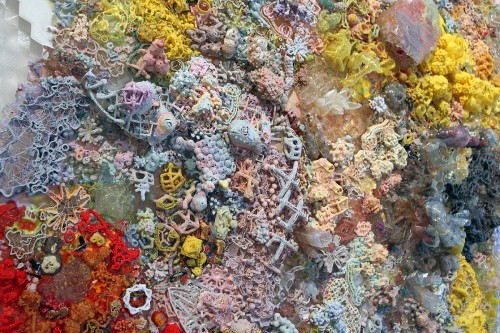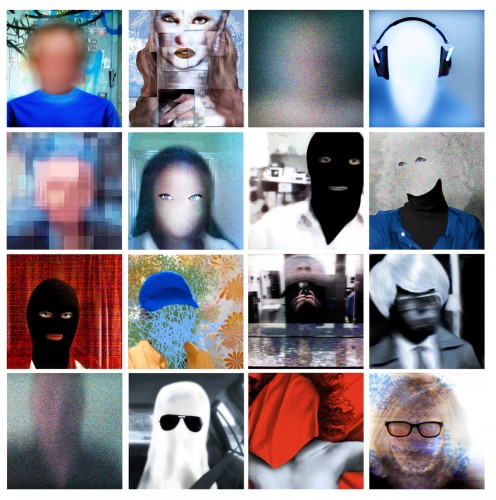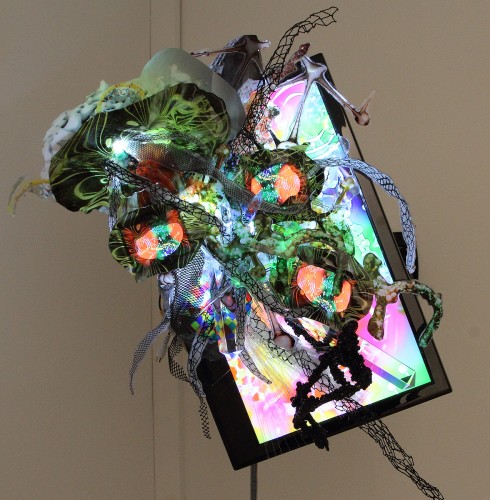Bricolage is a French word, with no direct equivalent in English. It connotes the process of finding out how to make things work, not from standard rules or methods but from messing around with whatever materials are on hand. This term suggests a sense of improvisation and tinkering that transforms the context and meaning of these objects, such as in works created by Sarah Sze. This is an important concept in contemporary art production and entrepreneurship. Michael Rush notes postmodern aesthetics discourse regarding how recent social-economic changes produce particular structures of feeling or cultural logics that are reflected in new art forms. Postmodernism also implies that we’ve run out of things to say. I think that we need to cast a much broader net to capture the spirit of the moment we’re in now; and expand definitions to capture innovative ideas such as the free use of digital images, objects and information. Holland Wilde writes that a bricoleur produces a “pieced-together set of representations that is fitted to the specifics of a complex situation…(it) is pragmatic, strategic and self-reflexive.” This blog post highlights artists and works as part of evolving creative practices that explore the spatial, social and cultural (technovernacular) dimensions of the material and virtual in a variety of ways.
I was invited to write a piece about Colliding Complexities_Extreme feats of the New York_New Aesthetic currently at view at Storefront Bushwick that features New York artists whose works navigate complex methods of production in the physical and digital realms. Their re-deployment of the New Aesthetic has as its core theme the “utilization of technological tools to augment our view of the contemporary world.” The New Aesthetic is understood as New Media without the “Media,” and, according to Bruce Sterling, concerns itself with “an explosion of the digital into the physical.” The art in Colliding Complexities exemplifies this concept from the perspective of “digital native” artists Pedro Barbeito, [dNASAb], Cliff Evans, Carla Gannis, Shane Hope, Michael Rees, John F. Simon Jr, Vargas-Suarez Universal, Oliver Warden and Marius Watz (who was recently interviewed for the Art21 Blog). Sterling writes that artists are “frontiersmen” of the “NEW” in their decision to adopt the tools of the “NOW,” to encourage further discourse and collaboration in the delineation of what constitutes the New Aesthetic in contemporary art.
“A sincere New Aesthetic would be a valiant, comprehensive effort to truly and sincerely engage with machine-generated imagery — not as a freak-show, a metaphor or a stimulus to the imagination — but *as it exists.*” – Bruce Sterling
Mobile devices, coded or augmented images and virtual artifacts represent our evolving capabilities. They also serve as metaphors for what artists of the New Aesthetic are doing and how they are experiencing both material and virtual worlds. Ryan Block writes that there are at least two things that seem certain about this development: “we are what we use, and we tend not to move backwards.” Our digital and mobile devices mediate our interactions and serve as an external representation of ourselves.
“It’s a pivotal time in human creative history. We are projecting ourselves into a virtual, digital domain. ‘We are human-projectors'” – [dNASAb]
Colliding Complexities’ artist-curator [dNASAb] posted video vignettes for the gallery audience to view on smartphones via a QR code. A few are posted here to illustrate some of the challenges and opportunities artists have to analyze computer-based, scientific data and artifacts from a variety of sources and summarize them into new works of art.

Shane Hope. “Scriptable-Scalable-Species-Tool-Being: Smartdustormin’ Mass-Mod-Mood-Meds,” 2012. 3D-printed PLA molecular models on acrylic substrate. Photo courtesy the artist.
In the late 1980s Joseph Nechvatal began creating paintings around the concept of the computer virus, i.e. by considering the image as a host for viruses: active agents whose role it is to manipulate and degrade the information contained in the image. Stéphane Sikora writes that the virus is “the basis of a creative process, producing newness in reference to the major influence of the virus on evolution in biological systems.” Shane Hope continues this type of work, as he states, by modifying, manipulating and designing molecular structures based on software.
The arts and sciences are similar in that they are expressions of what it is to be human in this world, and the artworks in Colliding Complexities are part of an ethos that, according to CERN researcher Ariane Koek is “unsubtle and still evolving.” Working in that space of collision between art and science are artists like Pedro Barbeito.
Oliver Warden discusses his use of scientific models and data visualizations as a relevant take on abstraction. Seeing nature through computer imagery is part of how we understand our world. He states that his work is about “matching the speed” in which his brain processes images “from the satellite, to the scientist, to the Internet, to me.”
Carla Gannis talks about building universes on her computer, i.e. through portraiture that subverts intrusions on privacy and explores the multiplicity of ideas that manifest in material and virtual worlds. In virtual worlds, artists can release conceptions of self and extend perceptions of self beyond real life, material, superficial, or traditional ideas. Cao Fei reflects on the behavior of avatars in Second Life and the motivations behind “real life” people who are both participants and observers.

Carla Gannis. “Non Facial Recognition,” 2012. Single-channel video. Dimensions variable. Photo courtesy the artist.
Vargas-Suarez Universal (Rafael Vargas-Suarez) uses paint to explore scientific imagery and information, i.e. by organizing these systems using vector-based graphics as building blocks for painting canvases. Patterns are one of the brain’s primary ways to process new information – it looks for information it already knows to “make new information fit.” Visionary artists re-interpret these patterns (and other ideas) in different ways. The process of finding correlations or patterns among fields in maps and vectors can be seen in works by Matthew Ritchie and Julie Mehretu, among a growing number of established artists.
That’s the big problem, as I see it: the New Aesthetic is trying to hack a modern aesthetic, instead of thinking hard enough and working hard enough to build one. – Bruce Sterling
I’ve been using the term “techno-vernacular” to describe the application of scientific, technological, thematic or mathematical knowledge for practical purposes, especially in the everyday (creative) practices of native or indigenous communities. Within the category of digital art, this term can be applied to several concepts. The practitioners whose works are in Colliding Complexities_Extreme feats of the New York_New Aesthetic are re-defining “native” as artists who value digital technology and use scientific artifacts and information to create artworks with a view to making an impact. Its arguable whether or not artists of the New Aesthetic are communicating using visual grammar more easily recognized by digital natives, or in ways that honor established traditions. Their works do not use a real language but take from a variety of real and virtual abstractions based on context. These contexts, according to Bruce Sterling, are “all cool, and most are rather interesting, and some are even profound, but they don’t march together.” I think that Sterling and Koek would agree on this New Aesthetic (fourth trend) problem. Koek quotes Dr. Michael Doser, an experimental physicist on CERN’s cultural board for the arts, who says:
“What I find wonderful about working with artists is that they are just as fascinated by side routes and diversions as they are by the direction in which they are going. This is what makes artistic work really different from scientific work.”
Perhaps it’s not that these disciplines need to march together, but that both should honor their differences and produce new works that highlight the unique, complex intersections between art, science and technology. The artists and practitioners whose works are featured in Colliding Complexities are exploring various questions and doing the meta. They offer their perspectives up front, so before we expend too much time and energy running in one direction, we can see if our true goals aren’t actually 180° from where they seem to be.
Colliding Complexities_Extreme feats of the New York_New Aesthetic runs through October 7 at the Storefront Bushwick Gallery in Brooklyn, NY.
The Digital Art Department at Pratt Institute is hosting a panel discussion on October 2, at 6:30pm.





Pingback: news | carla gannis
Pingback: New Aestheticism in Contemporary Art « SL Art HUD Blog Thingie:
Pingback: Art 2.1 | New Frontier at Sundance 2013: The Pixelated Pavilion | Art21 Blog
Pingback: ART21 + Nettrice Gaskins report on a group exhibition highlighting the complex intersections between art, science and technology. - [dNASAb]
Pingback: Thinking About The New Aesthetic and Art in the Digital Space | updownacross
Pingback: Art 3.0: Bringing Art & Culture to the Masses | SL Art HUD Blog Thingie:
Pingback: Realist Magic: Objects, Ontology, Causality | SL Art HUD Blog Thingie:
Pingback: news | carla gannis